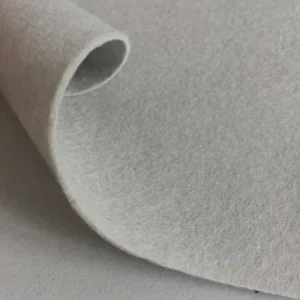As global textiles become increasingly diversified, the difference between these tissus et non-tissés has become an important question frequently asked by textile practitioners, engineering contractors, and even brand buyers. Especially in the rapidly developing application fields such as automotive nonwoven fabrics, infrastructure fabrics, and medical and health products, understanding the essential difference between these two fabrics is not only the key to material selection, but also related to product performance and sustainability.
This article will deeply analyze the difference between the two from four aspects: manufacturing process, structural characteristics, functional advantages, and typical applications. Combined with the high-performance product applications of Boshida, a professional nonwoven material manufacturer in China, you can more intuitively understand the broad prospects of tissu non tissés.

1. Manufacturing process: yarn weaving VS fiber straight fabric
Woven fabric is made by interlacing warp and weft yarns on a loom. The yarns are arranged in sequence, the structure is tight, and it has a certain elasticity and washability. It is widely used in clothing, home textiles, and industrial fabrics.
Nonwoven Fabric directly bonds the fibers together through physical or chemical methods without the need for spinning and weaving. Its main production methods include needle punching, spunbonding, spunlace, meltblowing, and other technologies. The short fiber needle punching method (Needle Punched Nonwoven) used by Boshida can quickly form a high-strength, evenly distributed cloth-like material with high efficiency, low energy consumption, and obvious cost advantages.
2. Differences in structure and performance: regular weaving vs. flexible structure
| Project | Woven Fabric | Nonwoven Fabric |
| Structure | Warp and weft interlaced, regular grid | Fibers are laid randomly, and the structure is varied. |
| Strength and stability | High tensile strength, suitable for long-term use | Depending on the yarn raw material, some are harder |
| Softness | It can adjust the breathability, and some applications, such as masks, require high breathability. | Usually softer, suitable for skin-friendly or strong covering occasions. |
| Breathability | Limited breathability, depending on yarn density | It can adjust the breathability, and some applications such as masks, require high breathability. |
| Price and efficiency | Complex process, slow production, high cost | Low cost, high efficiency, suitable for large-scale industrial-grade manufacturing |
The flexible structure of nonwoven fabrics allows it to have better filtration, isolation, breathability, and plasticity while maintaining a certain strength, and adapt to more complex functional scenarios. Taking Boshida’s PET staple needle-punched geotextile as an example. It has good corrosion resistance, aging resistance, anti-seepage, and impact resistance. It is widely used in infrastructure projects such as high-speed rail, subway, and water conservancy.
3. Application scenarios are very different: traditional textiles vs modern composite materials
Woven Fabric is mainly used in traditional clothing, household textiles, industrial covers, tents, and other scenarios that require long-term durability.
Nonwoven Fabric has become the new favorite of modern engineering and consumer goods, covering five high-growth areas:
- Infrastructure construction: nonwoven geotextiles, composite geomembranes, and GCL waterproof blankets are widely used in large-scale projects such as roads, railways, dams, and landfills. Boshida has participated in national key projects such as the South-to-North Water Diversion Project and the Qinghai-Tibet Railway. And has accumulated rich experience.
- Medical and health: antiviral masks, surgical gowns, disposable sheets, sanitary napkins, etc. Rely on the softness, breathability, and cleanliness of medical-grade nonwoven fabrics.
- Automotive interior: Lightweight flame-retardant materials have become mainstream. Such as the automotive seat bottom lining fabrics, sound-absorbing felts, and hard interior fabrics developed by Boshida. This helps reduce noise and weight of the entire vehicle.
- Home and clothing filling: Nonwoven fabrics can be used as sofa backing, mattress lining, headrest support, clothing filling cotton, etc. They are soft, environmentally friendly,y and easy to process.
- Filtration and industrial fabrics: high-strength filter media, used in air purification, industrial liquid treatment, and other fields.
4. Why are nonwoven fabrics becoming more and more important?
As the global demand for environmentally friendly, efficient and multifunctional materials increases, nonwoven fabrics are rapidly replacing some traditional woven materials. According to INDA 2023 data, global nonwoven fabric production will exceed 13.5 million tons in 2022, with an annual compound growth rate of 6.5%, much higher than the traditional textile industry.
As a leading company in the nonwoven industry, Boshida has 10 automated production lines. The annual production capacity is stable and reliable, and it can quickly respond to customized needs and serve global customers. Our products are widely exported to Southeast Asia, the Middle East, Europe, Latin America and other regions. And are deeply trusted.
5. Conclusion: How to choose the right fabric?
- If you focus on reusability, beautiful texture and strong structure, such as high-end clothing, furniture, heavy industrial masks, and woven fabrics are more suitable.
- If you focus on cost efficiency, strong functionality, and fast production speed, such as disposable products, environmentally friendly infrastructure, automotive interiors, and filtration applications, nonwoven fabrics should be given priority.
Boshida has been focusing on nonwoven materials for 33 years and provides a variety of functional nonwoven solutions. Including geotextiles, composite membranes, home fabrics, medical fabrics, shoe linings, sound-absorbing fabrics, etc. If you want to learn more or get a sample quotation, please nous contacter. We will provide you with professional support and personalized solutions.





